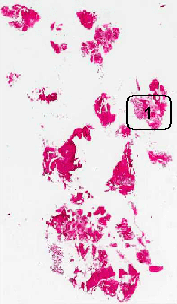
Case No.: W-001 Quiz
Diagnosis: Metastatic adenocarcinoma, lung origin
Organ: Vertebral column, L2
Last Updated: 12/22/2009
|
History: The patient was a 58 year-old woman with low back pain for about 5 months duration. There was no history of fall, trauma, or other events that precipitated the pain. The patient was a house wife and smoke about 1 pack of cigarettes a day but with denied the use of alcohol or drug. On CT imaging, an osteolytic lesion was demonstrated in the posterior elements of her L2 spine. A needle biopsy was performed and yielded the the current specimen.
Histologic Highlights of this Case:
|
Bonus Images:
|
Hematoxylin & eosin |
Additional high-magnification images: Note the relationship between the bone (B) and tumor cells (arrows). |
|
Hematoxylin & eosin |
Additional high-magnification images: Note the enlarged nuclei with nucleoli (arrow). |
|
Immunohistochemistry |
Pancytokeratin (AE1/AE3): Note the positive cells (brown cells) and bone (B). Most carcinomas are positive for this combination of cytokeratin on immunohistochemistry. |
|
Immunohistochemistry |
Cytokeratin 7: Cytokeratin 7 is often but not always positive in adenocarcinoma and small cell carcinoma arising from the lung. In contrast, cytokeratin 20 is often negative in these tumors. |
|
Immunohistochemistry |
Thyroid transcription factor 1 (TTF-1): TTF-1 is often positive in adenocarcinoma and small cell carcinoma of the lung. They are also positive in tumors of the thyroid gland. In contrast to the staining in AE1/AE3 and cytokeratin 7, the positive staining in TTF-1 is in the nuclei. |
Original slide is contributed by Dr. Kar-Ming Fung, University of Oklahoma Health Sciences Center, Oklahoma, U.S.A.